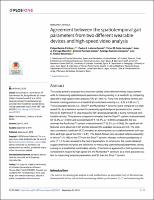Por favor, use este identificador para citar o enlazar este ítem:
https://repositorio.usj.es/handle/123456789/267
Registro completo de metadatos
| Campo DC | Valor | Lengua/Idioma |
|---|---|---|
| dc.contributor.author | García-Pinillos, Felipe | - |
| dc.contributor.author | Latorre-Román, Pedro Á. | - |
| dc.contributor.author | Soto-Hermoso, Víctor M. | - |
| dc.contributor.author | Párraga-Montilla, Juan A. | - |
| dc.contributor.author | Ramírez-Campillo, Rodrigo | - |
| dc.contributor.author | Roche-Seruendo, Luis Enrique | - |
| dc.date.accessioned | 2019-12-17T12:02:37Z | - |
| dc.date.available | 2019-12-17T12:02:37Z | - |
| dc.date.issued | 2019-09-24 | - |
| dc.identifier.citation | García-Pinillos F, Latorre-Román PÁ, Soto-Hermoso VM, Párraga-Montilla JA, Pantoja-Vallejo A, Ramírez-Campillo R, et al. (2019) Agreement between the spatiotemporal gait parameters from two different wearable devices and high-speed video analysis. PLoS ONE 14(9): e0222872. https://doi.org/10.1371/journal.pone.0222872 | es_ES |
| dc.identifier.issn | 1932-6203 | es_ES |
| dc.identifier.uri | https://repositorio.usj.es/handle/123456789/267 | - |
| dc.description.abstract | This study aimed to evaluate the concurrent validity of two different inertial measurement units for measuring spatiotemporal parameters during running on a treadmill, by comparing data with a high-speed video analysis (VA) at 1,000 Hz. Forty-nine endurance runners performed a running protocol on a treadmill at comfortable velocity (i.e., 3.25 ± 0.36 m.s-1). Those wearable devices (i.e., Stryd™ and RunScribe™ systems) were compared to a high-speed VA, as a reference system for measuring spatiotemporal parameters (i.e. contact time [CT], flight time [FT], step frequency [SF] and step length [SL]) during running at comfortable velocity. The pairwise comparison revealed that the Stryd™ system underestimated CT (5.2%, p < 0.001) and overestimated FT (15.1%, p < 0.001) compared to the VA; whereas the RunScribe™ system underestimated CT (2.3%, p = 0.009). No significant differences were observed in SF and SL between the wearable devices and VA. The intra class correlation coefficient (ICC) revealed an almost perfect association between both systems and high-speed VA (ICC > 0.81). The Bland-Altman plots revealed heteroscedasticity of error (r2 = 0.166) for the CT from the Stryd™ system, whereas no heteroscedasticity of error (r2 < 0.1) was revealed in the rest of parameters. In conclusion, the results obtained suggest that both foot pods are valid tools for measuring spatiotemporal parameters during running on a treadmill at comfortable velocity. If the limits of agreement of both systems are considered in respect to high-speed VA, the RunScribe™ seems to be a more accurate system for measuring temporal parameters and SL than the Stryd™ system. | es_ES |
| dc.format.extent | 11 p. | es_ES |
| dc.format.mimetype | application/pdf | es_ES |
| dc.language.iso | eng | es_ES |
| dc.publisher | Daniel Boullosa, University of Brasilia, BRAZIL | es_ES |
| dc.relation.requires | Adobe PDF | es_ES |
| dc.rights | Atribución 4.0 Internacional | * |
| dc.rights.uri | http://creativecommons.org/licenses/by/4.0/ | * |
| dc.subject | RunScribe™ | es_ES |
| dc.subject | Stryd™ | es_ES |
| dc.subject | Spatiotemporal parameters | es_ES |
| dc.subject | Running at comfortable velocity | es_ES |
| dc.title | Agreement between the spatiotemporal gait parameters from two different wearable devices and high-speed video analysis | es_ES |
| dc.type | info:eu-repo/semantics/article | es_ES |
| dc.subject.unesco | Estudio de caso | es_ES |
| dc.subject.unesco | Desarrollo fisiológico | es_ES |
| dc.subject.unesco | Desarrollo de la carrera | es_ES |
| dc.relation.publisherversion | https://journals.plos.org/plosone/article?id=10.1371/journal.pone.0222872 | es_ES |
| dc.identifier.doi | https://doi.org/10.1371/journal.pone.0222872 S | es_ES |
| dc.rights.accessrights | info:eu-repo/semantics/openAccess | es_ES |
| Aparece en las colecciones: | Artículos de revistas | |
Ficheros en este ítem:
| Fichero | Descripción | Tamaño | Formato | |
|---|---|---|---|---|
| journal.pone.0222872.pdf | 958,03 kB | Adobe PDF |  Visualizar/Abrir |
Este ítem está sujeto a una licencia Creative Commons Licencia Creative Commons

